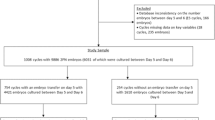Abstract
Purpose
To investigate the prognostic value of growth of 4-cell embryos on the day of transfer in determining clinical pregnancy and live birth rates after fresh in vitro fertilization (IVF)-embryo transfer (ET) cycles.
Methods
Retrospective cohort study of all patients between January 2008 and January 2013 initiating fresh IVF-ET cycles resulting in embryos that were not more than 4 cells 72 h after oocyte retrieval in the morning of their transfer. Patients were stratified into 2 groups based on whether embryos did or did not grow more than the 4-cell stage on the afternoon of ET. The odds of clinical pregnancy and live birth were considered as primary outcomes. Student’s t-tests and Chi-square (χ2) tests were used as inidicated, with logistic regression controlling for maternal age and number of embryos transferred.
Results
Three hundred forty three patients were identified for inclusion: 165 and 178 patients had 4-cell embryos with and without growth on the afternoon of ET, respectively. The demographic and baseline IVF cycle characteristics of the study cohort were comparable. Patients with embryo growth had higher clinical pregnancy (13.9 % vs. 4.49 %) and live birth (10.9 % vs. 3.37 %) rates compared to patients without embryo growth. This represented an overall increased odds of clinical pregnancy [Odds ratio (OR) = 3.44; 95 % Confidence Intervals (CI) 1.49–7.93; P = 0.004)] and live birth (OR = 3.51; 95 % CI 1.36–9.07; P = 0.01). The increased odds remained unchanged after adjusting for maternal age and number of embryos transferred.
Conclusions
Transfer of 4-cell embryos 3 days after oocyte retrieval can result in clinical pregnancies and live births, albeit at a low rate. Growth of an embryo more than the 4-cell stage on the afternoon of ET may serve as a positive prognostic factor for IVF-ET cycle outcome.
Similar content being viewed by others
References
Zhao P, Li M, Lian Y, Zheng X, Liu P, Qiao J. The clinical outcomes of day 3 4-cell embryos after extended in vitro culture. J Assist Reprod Genet. 2015;32(1):55–60.
Desai NN, Goldstein J, Rowland DY, Goldfarb JM. Morphological evaluation of human embryos and derivation of an embryo quality scoring system specific for day 3 embryos: a preliminary study. Hum Reprod. 2000;15(10):2190–6.
Ertzeid G, Storeng R, Tanbo T, Dale PO, Bjercke S, Abyholm T. Cycle characteristics of day 3 embryo transfers with 4-cell embryos only. J Assist Reprod Genet. 2003;20(9):352–7.
Cummins JM, Breen TM, Harrison KL, Shaw JM, Wilson LM, Hennessey JF. A formula for scoring human embryo growth rates in in vitro fertilization: its value in predicting pregnancy and in comparison with visual estimates of embryo quality. J In Vitro Fert Embryo Transf. 1986;3(5):284–95.
Trounson AO, Mohr LR, Wood C, Leeton JF. Effect of delayed insemination on in-vitro fertilization, culture and transfer of human embryos. J Reprod Fertil. 1982;64(2):285–94.
Claman P, Armant DR, Seibel MM, Wang TA, Oskowitz SP, Taymor ML. The impact of embryo quality and quantity on implantation and the establishment of viable pregnancies. J In Vitro Fert Embryo Transf. 1987;4(4):218–22.
Reichman DE, Chung P, Meyer L, Greenwood E, Davis O, Rosenwaks Z. Consecutive gonadotropin-releasing hormone-antagonist in vitro fertilization cycles: does the elapsed time interval between successive treatments affect outcomes? Fertil Steril. 2013;99:1277–82.
Veeck LL. An atlas of human gametes and conceptuses. An illustrated reference for assisted reproductive technology; 1999.
Hegde A, Behr B. Embryo culture and selection: morphological criteria. Human Fertility: Methods and Protocols. 1st Edition. Springer; 2014.
Giorgetti C, Terriou P, Auquier P, Hans E, Spach JL, Salzmann J, et al. Embryo score to predict implantation after in-vitro fertilization: based on 957 single embryo transfers. Hum Reprod. 1995;10(9):2427–31.
Ziebe S, Petersen K, Lindenberg S, Andersen AG, Gabrielsen A, Andersen AN. Embryo morphology or cleavage stage: how to select the best embryos for transfer after in-vitro fertilization. Hum Reprod. 1997;12(7):1545–9.
Van Royen E, Mangelschots K, De Neubourg D, Valkenburg M, Van de Meerssche M, Ryckaert G, et al. Characterization of a top quality embryo, a step towards single-embryo transfer. Hum Reprod. 1999;14(9):2345–9.
Steer CV, Mills CL, Tan SL, Campbell S, Edwards RG. The cumulative embryo score: a predictive embryo scoring technique to select the optimal number of embryos to transfer in an in-vitro fertilization and embryo transfer programme. Hum Reprod. 1992;7(1):117–9.
Desai NN, Goldstein J, Rowland DY, Goldfarb JM. Morphological evaluation of human embryos and derivation of an embryo quality scoring system specific for day 3 embryos: a preliminary study. Hum Reprod. 2000;15(10):2190–6.
Janny L, Menezo YJ. Maternal age effect on early human embryonic development and blastocyst formation. Mol Reprod Dev. 1996;45(1):31–7.
Tesarik J, Mendoza C, Greco E. Paternal effects acting during the first cell cycle of human preimplantation development after ICSI. Hum Reprod. 2002;17(1):184–9.
Tesarik J. Paternal effects on cell division in the human preimplantation embryo. Reprod Biomed Online. 2005;10(3):370–5.
Capalbo A, Rienzi L, Cimadomo D, Maggiulli R, Elliott T, Wright G, et al. Correlation between standard blastocyst morphology, euploidy and implantation: an observational study in two centers involving 956 screened blastocysts. Hum Reprod. 2014;29(6):1173–81.
Conflict of Interest
The authors declare that they have no conflict of interest
Author information
Authors and Affiliations
Corresponding author
Additional information
Capsule Growth of a day-3 embryo beyond the 4-cell stage on the afternoon of transfer may serve as a positive prognostic factor for IVF-ET cycle outcome.
Rights and permissions
About this article
Cite this article
Pereira, N., Brauer, A.A., Melnick, A.P. et al. Prognostic value of growth of 4-cell embryos on the day of transfer in fresh IVF-ET cycles. J Assist Reprod Genet 32, 939–943 (2015). https://doi.org/10.1007/s10815-015-0478-2
Received:
Accepted:
Published:
Issue Date:
DOI: https://doi.org/10.1007/s10815-015-0478-2




